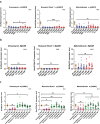An unusual Toll/MyD88-mediated Drosophila host defence against Talaromyces marneffei
- PMID: 39239739
- PMCID: PMC11382710
- DOI: 10.1080/19336934.2024.2398300
An unusual Toll/MyD88-mediated Drosophila host defence against Talaromyces marneffei
Abstract
Talaromycosis, caused by Talaromyces marneffei (T. marneffei, formerly known as Penicillium marneffei), is an opportunistic invasive mycosis endemic in tropical and subtropical areas of Asia with high mortality rate. Despite various infection models established to study the immunological interaction between T. marneffei and the host, the pathogenicity of this fungus is not yet fully understood. So far, Drosophila melanogaster, a well-established genetic model organism to study innate immunity, has not been used in related research on T. marneffei. In this study, we provide the initial characterization of a systemic infection model of T. marneffei in the D. melanogaster host. Survival curves and fungal loads were tested as well as Toll pathway activation was quantified by RT-qPCR of several antimicrobial peptide (AMP) genes including Drosomycin, Metchnikowin, and Bomanin Short 1. We discovered that whereas most wild-type flies were able to overcome the infection, MyD88 or Toll mutant flies failed to prevent fungal dissemination and proliferation and ultimately succumbed to this challenge. Unexpectedly, the induction of classical Toll pathway activation readouts, Drosomycin and Bomanin Short 1, by live or killed T. marneffei was quite limited in wild-type flies, suggesting that the fungus largely escapes detection by the systemic immune system. This unusual situation of a poor systemic activation of the Toll pathway and a strong susceptibility phenotype of MyD88/Toll might be accounted for by a requirement for this host defence in only specific tissues, a hypothesis that remains to be rigorously tested.
Keywords: Drosophila melanogaster infection model; Toll pathway activation; detection of fungal infections; resistance; talaromycosis.
Conflict of interest statement
No potential conflict of interest was reported by the author(s).
Figures




Similar articles
-
An Overlooked and Underrated Endemic Mycosis-Talaromycosis and the Pathogenic Fungus Talaromyces marneffei.Clin Microbiol Rev. 2023 Mar 23;36(1):e0005122. doi: 10.1128/cmr.00051-22. Epub 2023 Jan 17. Clin Microbiol Rev. 2023. PMID: 36648228 Free PMC article. Review.
-
A negative role for MyD88 in the resistance to starvation as revealed in an intestinal infection of Drosophila melanogaster with the Gram-positive bacterium Staphylococcus xylosus.Immunobiology. 2013 Apr;218(4):635-44. doi: 10.1016/j.imbio.2012.07.027. Epub 2012 Sep 13. Immunobiology. 2013. PMID: 23083631
-
The Drosophila Toll pathway controls but does not clear Candida glabrata infections.J Immunol. 2013 Mar 15;190(6):2818-27. doi: 10.4049/jimmunol.1201861. Epub 2013 Feb 11. J Immunol. 2013. PMID: 23401590
-
Spn1 regulates the GNBP3-dependent Toll signaling pathway in Drosophila melanogaster.Mol Cell Biol. 2011 Jul;31(14):2960-72. doi: 10.1128/MCB.01397-10. Epub 2011 May 16. Mol Cell Biol. 2011. PMID: 21576362 Free PMC article.
-
Talaromycosis (Penicilliosis) Due to Talaromyces (Penicillium) marneffei: Insights into the Clinical Trends of a Major Fungal Disease 60 Years After the Discovery of the Pathogen.Mycopathologia. 2019 Dec;184(6):709-720. doi: 10.1007/s11046-019-00410-2. Mycopathologia. 2019. PMID: 31811603 Review.
References
-
- Tang BS, Chan JF, Chen M, et al. Disseminated penicilliosis, recurrent bacteremic nontyphoidal salmonellosis, and burkholderiosis associated with acquired immunodeficiency due to autoantibody against gamma interferon. Clin Vaccine Immunol. 2010;17(7):1132–1138. doi: 10.1128/CVI.00053-10 - DOI - PMC - PubMed
MeSH terms
Substances
Supplementary concepts
LinkOut - more resources
Full Text Sources
Other Literature Sources
Molecular Biology Databases
